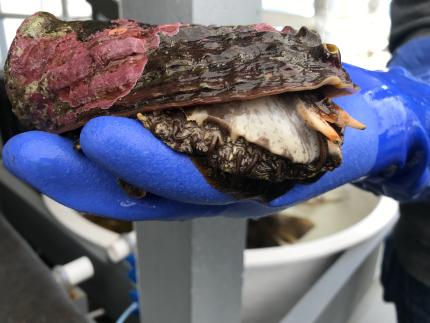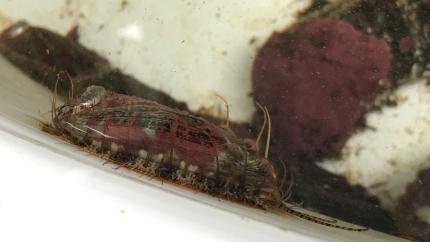ARCHIVED NEWS RELEASE
This document is provided for archival purposes only. Archived documents
do not reflect current WDFW regulations or policy and may contain factual
inaccuracies.
News release May 31, 2019
Henry Carson, (360) 888-8494; Jason Wettstein (360) 902-2254
OLYMPIA – The Washington Department of Fish and Wildlife (WDFW) is working with federal and state

partners to protect and conserve a species of large sea snail with a shell, a taste, and lifestyle that led to its wide-scale destruction.
The pinto abalone -- the only abalone species native to Washington -- has experienced a drastic reduction in population in recent decades. From 1992-2017, the population fell by an estimated 97 percent, putting the species at risk of local extinction.
Historically prized as food and for its contrasting red and green shell with an iridescent interior, pinto abalone is a species too popular for its own good.
Overfishing over decades starting in the 1960s led to population declines. While the agency and partners acted to protect the snails, including closing the fishery in 1994, significant levels of poaching and the abalone’s distinctive reproductive cycle meant a cycle of continuing declines despite action.
“Males and females spawn directly into the water, and without sufficient population density, fertilization does not occur, and the animals fail to reproduce,” said Hank Carson, WDFW research scientist.
Now partners are expanding the pinto abalone recovery effort at conservation hatchery facilities at the

Kenneth K. Chew Center for Shellfish Research and Restoration in Kitsap County.
"Our abalone captive-breeding and reintroduction program is a promising recovery strategy, but much work remains to achieve self-sustaining populations in the state," said Carson.
With the listing determination in hand after the commission decision today, the agency is set to conduct this work with long-time partners such as NOAA and the Puget Sound Restoration Fund.
Next steps include writing a formal recovery plan to reduce threats and build the species population, establishing additional satellite growing facilities to increase production, a conservation genetics and disease-risk assessment, and expansion of field work to determine the best places to out-plant these rare and distinctive creatures.
The 2019 legislature has supported funding to recover pinto abalone, including $900,000 for work through June 2021.
“When it comes to recovery of the Puget Sound ecosystem, everything is connected and attention to detail is important,” said Senator Christine Rolfes from Washington’s 23rd district. “Recovery of lesser-known species like the nearly depleted pinto abalone is critical for a healthy and more resilient Puget Sound and the salmon and orca whales we all love. I’m glad the legislature agreed to support this effort,” she added.
Carson said he is grateful for the partners and people who support pinto abalone work. “This species is far too interesting and valuable to disappear from Washington’s waters,” he said.
For more information about the pinto abalone in Washington, see WDFW’s website at https://wdfw.wa.gov/species-habitats/species/haliotis-kamtschatkana.